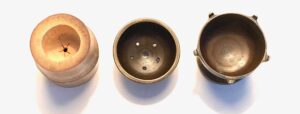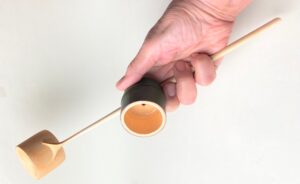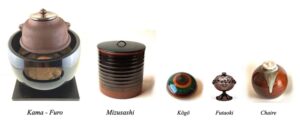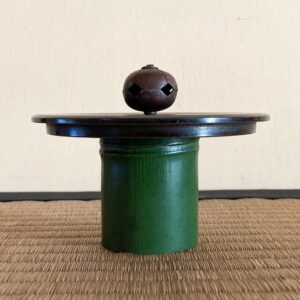Futaoki and the Number Five

Left: ao-dake hiki-kiri futa-oki, 青竹引切蓋置, green-bamboo draw-cut lid-place; H. 1.8 sun kane-jaku.
Right: ho-ya gō-ro futa-oki, 火舎香炉蓋置, fire-house incense-hearth lid-place, bronze; H. 1.8 sun kujira-jaku; with design of un-ryū, 雲龍, cloud-dragon, five ana, 穴, holes, and five tsume, 爪, talons, topped with a model of a hō-ju, 宝珠, treasure-jewel. The form of the hoya futaoki is also based on the treasure-jewel, which is undifferentiated In Yō, 陰陽, Yin Yang, receptive penetrative.
There are certain Tea utensils that are essential for preparing tea in Chanoyu. The kama, 釜, kettle, has no handle or spout for pouring water, so that the lid must be removed to access the water. Water is ladled with a hi-shaku, 柄杓, handle-ladle. The kama lid is placed on an object rather than simply on the floor. A futa-oki, 蓋置, lid-place, supplies that need, and it can be almost anything that accommodates the lid. The simplest is a small length of bamboo. The preferred kind of bamboo for futaoki is ma-dake, 真竹, true-bamboo, Japanese timber bamboo (Phyllostachys bambusoides). There is a robust type of bamboo named ‘Ryū-chiku’, 龍竹, Dragon-bamboo.
The futaoki is cut from the bamboo stalk so that the futaoki is upside down as the bamboo grows. It is changed from Yō as it grows, to In in its function as a futaoki. Bamboo is a natural container, which is In, so that cutting a hole in the septum lets water and air pass through becoming Yō. As a futaoki it is by nature both In and Yō. Originally, the futaoki was part of a set of bronze utensils called kai-gu, 皆具, all-tools, believed to have originated in China, and which included a small cylinder or wa, 輪, ring, to support the kettle lid.
Sen no Rikyū selected seven objects that could be used as a futaoki. One of them is the ho-ya gō-ro futa-oki, 火舎香炉蓋置, fire-house incense-heareth lid-place, which was borrowed from the Buddhist altar. However, Rikyū also used a bamboo futaoki for simple Tea presentations, a custom which continues to the present. All futaoki have, or should have, some association with water, or other feature, such as a symbolic number, for example 5, go, 五. There are countless manifestations of groups of five in Japanese culture, and especially in Chanoyu. The genesis of this concept may be found in the five fingers and five toes of human beings. This is a brief look at one aspect of the futaoki.

Left: naka-bushi take futa-oki,中節竹蓋置, middle-node bamboo lid-place, with a five-pointed hole in septum. Center: inverted lid of a Kara-kane, 唐銅, Tang-copper, ho-ya gō-ro futa-oki, 火舎香炉蓋置, fire-house incense-heareth lid-place, with five holes. Right: base of the hoya gōro futaoki with five tsume, 爪, talons.
The hoya gōro futaoki often has a design of a tatsu, 龍, dragon, on the lid, so that the tsume are related to the dragon’s talons. In ancient China, the five-talon dragon was related to the imperial court. Some hoya gōro futaoki have six talons and six corresponding holes, which may relate to the six-talon dragon that was reserved solely for the emperor.
The dragon is symbolic of Zen Buddhist enlightenment, satori, 悟. The Kanji is composed of kokoro, 心, heart, and waga, 吾, I, me, one’s own. My heart. The Kanji for waga, 吾, is composed of go, 五, five, and kuchi, 口, opening, just as there are five openings in the lid of the hoya gōro futaoki.
A hoya gōro futaoki with six talons and six openings is, perhaps, associated with the Roku-shiki, 六識, Six-consciousnesses. These are the consciousnesses of the six sense organs: seeing, hearing, smelling, tasting, touching, and reasoning.
The front or shō-men, 正面, correct-face, of a utensil is determined by different features. An object with an odd number of aspects, as with the talons of the hoya gōro futaoki, one of the talons is the shōmen. If there is an even number of aspects, such as the six-talon hoya gōro futaoki, two talons become shōmen.
Five is a Yō number, six is an In number. Six is also symbolic of Water. The Asian dragon brings water, so that its presence protects against fire.
There are many groups of six, and in Buddhism there is a phrase composed of six syllables believed to have been said by the Buddha: “Go-kon tō-i jo setsu”, 吾今当為汝説, I now must purpose you teach. The Kanji for go, waga, ware, 吾, means I (the Buddha). This Kanji 吾 is composed of the number five, go, 五, and mouth, ro, kuchi, 口, and is thought to be a pictograph of a ‘hand’ above an open mouth. This expression is used in Buddhist scriptures and stories when the Buddha preached. The hand is used to remove the lid to open the mouth of the kettle, the water jar, the tea container, for things that will enter the mouth of the person drinking tea.
The passage, “Gokon tōi jo setsu”, is from the U-ra-ban-kyō, 盂蘭盆経, Bowl-orchid-tray-sutra, that is the foundation of O-bon, お盆, Hon.-tray, rites and festivals that welcome back departed spirits. The Kanji ran, 蘭, also means government office that handles documents, balustrade railing, etc.
The openings in the bamboo and hoya gōro futaoki, are called in Japanese, ana, 穴, opening. There may be some significance to the five small radiating cuts made in the hole and the five holes in the hoya gōro futaoki. The Kanji for ana, 穴, is composed of the Kanji radical u-kanmuri, 宀, u-crown, meaning ‘roof’, and hachi, 八, eight. There is another Kanji for hole, ana, 坎 , hole, pit, etc. which is the name of one of the eight trigrams of the the Eki-kyō, I Ching, 易経, Change-sutra. It is identified with the North, and the Void. The word, ana, meaning ‘hole’ may have roots in Sanskrit implying ‘without’.
The Kanji for ana, 穴, is present in the Kanji for sora, 空, sky. It has further importance as the Kanji, 空, is also read, kū, 空, which means the Void. The Void, undifferentiated In Yō, is one of the Buddhist Go-rin, 五輪, Five-rings, five principles.
When the futaoki is used in preparing koi-cha, 濃茶, thick-tea, most futaoki are covered with the kama no futa, 釜の蓋, kettle’s-lid, or the bamboo hi-shaku, 柄杓, handle-ladle. The hoya gōro futaoki is covered with the kama no futa or its own lid. When handling any one of the many of the various futaoki, it is frequently covered with the right hand.

The five-pointed hole of the bamboo futaoki and the five holes may represent the Go-gyō, 五行, Five-transitions, the five physical elements, and the Go-rin, 五輪, Five-rings, five principals. There are five utensils that are essential to preparing a bowl of tea in Chanoyu in formal presentations that have lids. These are the five utensils. The hoya gōro futaoki is a great exception in the realm of futaoki, as it must remain in the Tearoom displayed on an ‘earth’ board. It is a reminder of its origin in a Buddhist or worship hall.

Cha-dō-gu, 茶道具, Tea-way-tools, and the Go-Rin, 五輪, Five-rings:
Kama-furo, 釜風炉, kettle – wind-hearth; represents Chi, 地, Earth, the foundation of everything.
Mizu-sashi, 水指, water-indicate; represents Sui, 水, Water, as it contains water, and it can assume any form.
Kō-gō, 香合, incense-gather; represents Ka, 火, Fire, as incense is put into the hearth fire, and it can transform.
Futa-oki, 蓋置, lid-place; represents Fū, 風, Wind, as uncovered and covered changes its Yō and In, 陽 and 陰.
Cha-ire, 茶入, tea-receptacle; represents Kū, 空, Void, as tea unites with hot water, and become undifferentiated In Yō.
These five utensils that are essential in the more formal Tea presentations called, ten-mae, 點前, offer-fore. The Kanji for ten, 點, offer is composed of five Kanji: Chi, 地, Earth, Sui, 水, Water, Ka, 火, Fire, Fū, 風, Wind, Kū, 空, Void. Each of the five utensils have lids, futa, 蓋, which is also read gai. In Buddhism, there are the Go-gai, 五蓋, Five-lids, or five covers, hindrances, etc.
- Desire: Sensory desire for pleasure through sight, sound, smell, taste, and touch.
- Anger: Ill-will, feelings of hostility, resentment, hatred, and bitterness.
- Sleepy: Sloth, torpor half-hearted action with little or no effort or concentration.
- Distraction: Restlessness, worry, inability to calm the mind and focus one’s energy.
- Doubt: Lack of conviction or trust in one’s abilities.
Which, if any, of the utensils may be identified with which of the Five Covers is up for debate. However, the first of the Five Hindrances is Kama which is identified with the five physical senses, which are in accord with the physical aspects, Gogyō, of the furo/kama. It is a curious coincidence of homonyms of kama for the kettle and kama for the Hindu and Buddhist realm of desire.
There are close similarities between the two-part spherical tsumami of the kama no futa and the two-part spherical hoya gōro futaoki. Incense is essential to Chanoyu. The tsumami of the kama lid is in the form of three five-petal ume no hana, 梅の花, ‘plum’s flower. The ume, 梅, Japanese apricot, is an emblem of spring and renewal, and its fragrance fills the Buddhist world. Several kinds of blended neri-kō, 練香, knead-incense, have names the include the word ume, such as ‘Ume ga ka’, 梅が香, ‘Plum’s fragrance. Japan’s oldest weeping ume tree is named ‘Ame no Ryū’, 天の龍, Heaven ’s Dragon. The kettle’s lugs, kan-tsuki, 鐶付, metal ring-attach, are often in the form of ki-men, 鬼面, demon-face, which may be inspired by the dragon.

Ao-dake futa-oki, 青竹蓋置, green-bamboo lid-place, supporting a kama no futa, 釜の蓋, kettle’s lid, which has a spherical tsumami, 摘, pinch, in the form of two five-petal ume no hana, 梅の花, plum’s flower.
For further study see also: Opening the Furo: Tsumami and Futaoki
For further information on the Five Hinderances, see: Unhindered by Gil Fronsdale.

